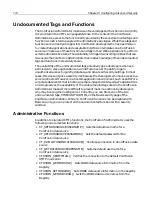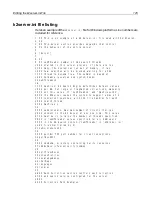
110
Chapter 5 Configuring Advanced Security
Undocumented Tags and Functions
The ColdFusion Administrator makes use of several tags and functions not currently
documented in the CFML Language Reference. In the context of the ColdFusion
Administrator, access to the functionality provided by these undocumented tags and
functions is restricted to people with administrative privileges. While these tags and
functions are currently unsupported, ColdFusion developers who have permission
to create Web applications and executable ColdFusion templates on a ColdFusion
server can make use of these functions and tags in their Web applications to perform
certain administrative tasks. The availability of illegal de-encoding utilities that can
de-encode the ColdFusion Administrator has made knowledge of the undocumented
tags and functions more widely known.
The availability of the undocumented tags potentially gives developers who have
permission to place applications on a ColdFusion server the ability to gain
unauthorized access to registry, database, and Advanced Security settings. In most
cases, this does not pose a security risk because the developers who have access to a
server are trusted. However, in a hosted-application environment, such as an ISP or a
corporate data center that is hosting multiple independent developer’s applications
on a single server, the availability of the undocumented tags used in the ColdFusion
Administrator makes it more difficult to prevent malicious actions by developers
who may be using the hosting server. Currently, you can block one of the two
undocumented tags, CFSECURITYADMIN, on the Basic security page of the
ColdFusion Administrator. While no ColdFusion functions can be disabled with
Basic security, you can protect all the undocumented functions with a security
sandbox.
Administrative Functions
In addition to standard CFML functions, the ColdFusion 5 Administrator uses the
following undocumented functions:
•
CF_SETDATASOURCEUSERNAME()
Sets the default user name for a
ColdFusion data source
•
CF_SETDATASOURCEPASSWORD()
Sets the default password for the
ColdFusion data source
•
CF_ISCOLDFUSIONDATASOURCE()
Verifies a connection to a ColdFusion data
source
•
CF_GETDATASOURCEUSERNAME()
Gets the default user name for a
ColdFusion data source
•
CFUSION_VERIFYMAIL()
Verifies the connection to the default ColdFusion
SMTP mail server
•
CFUSION_GETODBCINI()
Gets ODBC data source information from the
Registry
•
CFUSION_SETODBCINI()
Sets ODBC data source information in the Registry
•
CFUSION_GETODBCDSN()
Gets the ODBC data source names from the
Registry
Summary of Contents for COLDFUSION 5-ADVANCED ADMINISTRATION
Page 1: ...Macromedia Incorporated Advanced ColdFusion Administration ColdFusion 5...
Page 20: ......
Page 56: ...38 Chapter 1 Advanced Data Source Management...
Page 74: ...56 Chapter 2 Administrator Tools...
Page 76: ......
Page 86: ...68 Chapter 3 ColdFusion Security...
Page 87: ...To Learn More About Security 69...
Page 88: ...70 Chapter 3 ColdFusion Security...
Page 130: ...112 Chapter 5 Configuring Advanced Security...
Page 132: ......
Page 154: ...136 Chapter 6 Configuring Verity K2 Server...
Page 162: ...144 Chapter 7 Indexing XML Documents...
Page 202: ...184 Chapter 8 Verity Spider...
Page 236: ...218 Chapter 10 Verity Troubleshooting Utilities...
Page 238: ......
Page 348: ...330 Chapter 14 ClusterCATS Utilities...
Page 349: ...Using sniff 331...
Page 350: ...332 Chapter 14 ClusterCATS Utilities...
Page 362: ...344 Chapter 15 Optimizing ClusterCATS...
Page 372: ...354 Index...
















































